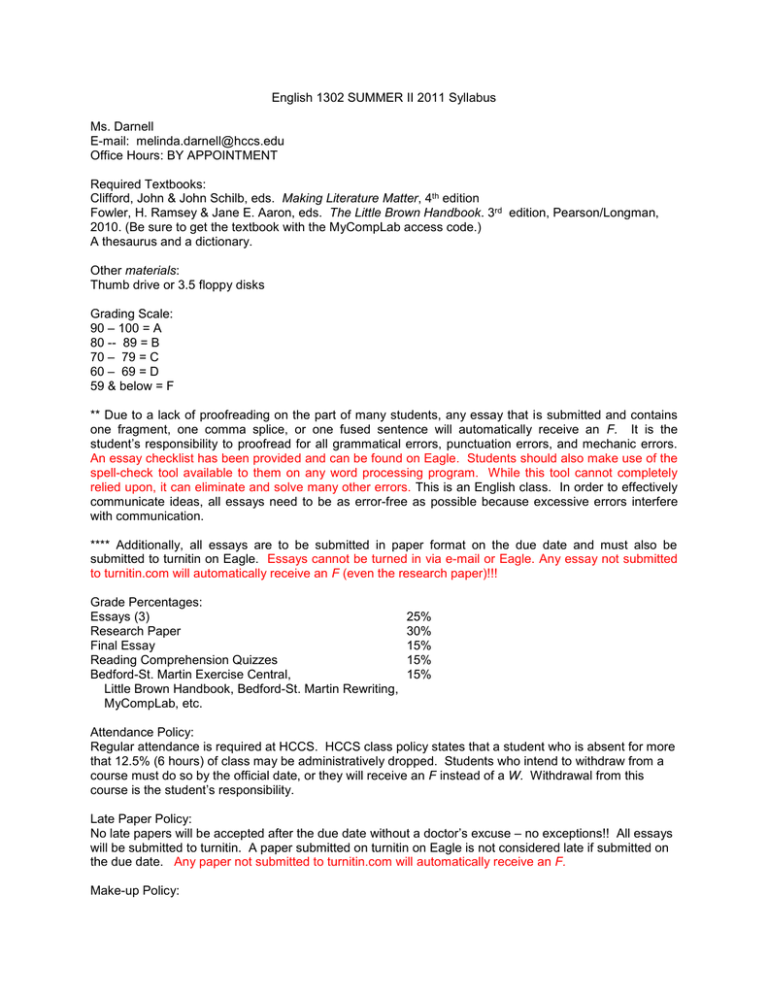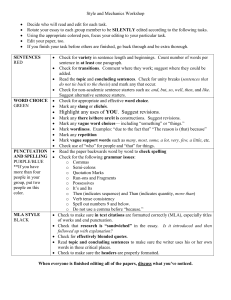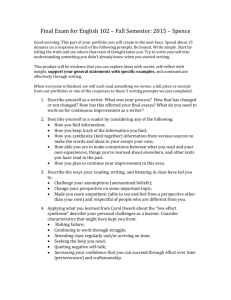
English 1302 SUMMER II 2011 Syllabus
Ms. Darnell
E-mail: melinda.darnell@hccs.edu
Office Hours: BY APPOINTMENT
Required Textbooks:
Clifford, John & John Schilb, eds. Making Literature Matter, 4th edition
Fowler, H. Ramsey & Jane E. Aaron, eds. The Little Brown Handbook. 3rd edition, Pearson/Longman,
2010. (Be sure to get the textbook with the MyCompLab access code.)
A thesaurus and a dictionary.
Other materials:
Thumb drive or 3.5 floppy disks
Grading Scale:
90 – 100 = A
80 -- 89 = B
70 – 79 = C
60 – 69 = D
59 & below = F
** Due to a lack of proofreading on the part of many students, any essay that is submitted and contains
one fragment, one comma splice, or one fused sentence will automatically receive an F. It is the
student’s responsibility to proofread for all grammatical errors, punctuation errors, and mechanic errors.
An essay checklist has been provided and can be found on Eagle. Students should also make use of the
spell-check tool available to them on any word processing program. While this tool cannot completely
relied upon, it can eliminate and solve many other errors. This is an English class. In order to effectively
communicate ideas, all essays need to be as error-free as possible because excessive errors interfere
with communication.
**** Additionally, all essays are to be submitted in paper format on the due date and must also be
submitted to turnitin on Eagle. Essays cannot be turned in via e-mail or Eagle. Any essay not submitted
to turnitin.com will automatically receive an F (even the research paper)!!!
Grade Percentages:
Essays (3)
Research Paper
Final Essay
Reading Comprehension Quizzes
Bedford-St. Martin Exercise Central,
Little Brown Handbook, Bedford-St. Martin Rewriting,
MyCompLab, etc.
25%
30%
15%
15%
15%
Attendance Policy:
Regular attendance is required at HCCS. HCCS class policy states that a student who is absent for more
that 12.5% (6 hours) of class may be administratively dropped. Students who intend to withdraw from a
course must do so by the official date, or they will receive an F instead of a W. Withdrawal from this
course is the student’s responsibility.
Late Paper Policy:
No late papers will be accepted after the due date without a doctor’s excuse – no exceptions!! All essays
will be submitted to turnitin. A paper submitted on turnitin on Eagle is not considered late if submitted on
the due date. Any paper not submitted to turnitin.com will automatically receive an F.
Make-up Policy:
Students will be allowed to make-up quizzes and/or assignments if they have a doctor’s excuse. It is the
student’s responsibility to make the arrangements for make-ups. Make-ups must be done within 3 days
of the student’s return to class – no exceptions!!
Paper Format:
Out of class assignments are to be typed and double-spaced per MLA style.
300 -- 500 words for essays; 1,000 to 1,500 words for research paper
All typed assignments must adhere to MLA format unless otherwise specified.
Be sure to use the Arial font; the font size needs to be size 12.
Course Policies:
Please turn off cell phones and keep them out of sight (either in a book bag or purse)
No tape recording devices allowed
Please do not bring children, boy/girl friends, family members, etc. to class with you
Please make an effort to be on time for class. Three tardies will count as 1 unexcused absence.
Web Links:
http://bcs.bedfordstmartins.com/exercisecentral
http://bcs.bedfordstmartins.com/rewriting
www.mycomplab.com
SCHOLASTIC DISHONESTY:
According to the 2006-2009 Student Handbook for the Houston Community College System:
“Students are responsible for conducting themselves with honor and integrity in fulfilling course
requirements. Penalties and/or disciplinary proceedings may be initiated by College System officials
against a student accused of scholastic dishonesty. ‘Scholastic dishonesty’ includes, but is not limited to,
cheating on a test, plagiarism, and collusion. ‘Cheating’ on a test includes:
-- Copying from another student’s test paper;
--Using materials during a test that are not authorized by the person giving the test;
--Collaborating with another student during a test without authority;
--Knowingly using, buying, selling, stealing, transporting, or soliciting in whole or part the contents
of an unadministered test;
--Bribing another person to obtain a test that is to be administered.
‘Plagiarism’ means the appropriation of another’s work and the unacknowledged incorporation
of that work in one’s own written work offered for credit.
‘Collusion’ means the unauthorized collaboration with another person in preparing written work
offered for credit” (34-35).
Please note the possible consequences of such dishonesty, as stated in the 2006-2009 Student
Handbook: Possible punishments for academic dishonesty may include a grade of “0” or “F” for the
particular assignment, failure in the course, and/or recommendation for probation or dismissal from the
College System (35).
Plagiarism Policy
Plagiarized papers or projects will receive a grade of “0” (zero) -- no exceptions. Cheating or collusion will
also result in a grade of “0” (zero) on that paper or project. Plagiarism or collusion on a second major
assignment will result in a zero in the course. Students need to be aware that the instructor will be
utilizing plagiarism software and internet sources to check student work for potential plagiarism. This will
be discussed in more detail during class lecture.
ENGLISH 13O2 COURSE DESCRIPTION
English 1302 is a more extensive study of the skills introduced in English 1301 with an emphasis on
critical thinking, research and documentation techniques, and literary and rhetorical analysis. English
1302 is a core curriculum course.
SLO
1.
Apply basic principles of rhetorical analysis.
2.
Write essays that classify, explain, and evaluate rhetorical and
literary strategies employed in argument, persuasion, and various forms of
literature.
3.
Identify, differentiate, integrate, and synthesize research materials
into argumentative and/or analytical essays.
4.
Employ appropriate documentation style and format across the spectrum of
in-class and out-of-class written discourse.
5.
Demonstrate library literacy.
HCCS CORE CURRICULUM INTELLECTUAL COMPETENCIES AND EXEMPLARY EDUCATIONAL
OBJECTIVES -- ENGLISH 1301 AND 1302
______________________________________________________________________________
I. BASIC INTELLECTUAL COMPETENCIES IN HCCS CORE
·
·
·
·
·
·
READING: Reading material at the college level means having the ability to analyze and interpret a
variety of materials -- books, articles, and documents.
WRITING: Writing at the college level means having the ability to produce clear, correct, and
coherent prose adapted to purpose, occasion, and audience. In addition to knowing correct grammar,
spelling, and punctuation, students should also become familiar with the writing process, including
how to discover a topic, how to develop and organize it, and how to phrase it effectively for their
audience. These abilities are acquired through practice and reflection.
SPEAKING: Effective speaking is the ability to communicate orally in clear, coherent, and persuasive
language appropriate to purpose, occasion, and audience.
LISTENING: Listening at the college level means the ability to analyze and interpret various forms of
spoken communication.
CRITICAL THINKING: Critical thinking embraces methods of applying both qualitative and
quantitative skills analytically and creatively to subject matter in order to evaluate arguments and to
construct alternative strategies. Problem solving is one of the applications of critical thinking used to
address an identified task.
COMPUTER LITERACY: Computer literacy at the college level means having the ability to use
computer-based technology in communicating, solving problems, and acquiring information. Coreeducated students should have an understanding of the limits, problems, and possibilities associated
with the use of technology and should have the tools necessary to evaluate and learn new
technologies as they become available.
II. EXEMPLARY EDUCATIONAL OBJECTIVES: FRESHMAN ENGLISH
·
·
·
·
To understand and demonstrate writing and speaking processes through invention, organization,
drafting, revision, editing, and presentation.
To understand the importance of specifying audience and purpose and to select appropriate
communication choices.
To understand and appropriately apply modes of expression (descriptive, expository, narrative,
scientific, and self-expressive) in written, visual, and oral communication.
To participate effectively in groups with emphasis on listening, critical and reflective thinking, and
responding.
·
To understand and apply basic principles of critical thinking, problem solving, and technical
proficiency in the development of exposition and argument.
To develop the ability to research and write a documented paper and/or give an oral
presentation.
**Any aspect of this syllabus is subject to change when deemed necessary by the instructor.
Tentative Schedule:
Introduction to the short story
Wharton, “Roman Fever”
Poe, “The Cask of Amontillado”
Hemingway, “Hills Like White Elephants” and “A Clean, Well-Lighted Place”
Chekov, “The Lady with the Pet Dog”
Chopin, “The Storm” and “The Story of an Hour”
Joyce, “Araby”
Mansfield, “Miss Brill”
Walker, “Everday Use”
Hawthorne, “Young Goodman Brown”
O’Connor, “A Good Man is Hard to Find”
Introduction to drama
Sophocles, Oedipus Rex
Shakespeare, Hamlet
Introduction to Poetry
RESEARCH PAPER REQUIREMENTS
1.
2.
3.
4.
5.
SELECT ONE OF THE SHORT STORIES FROM THE READING LIST.
1000 – 1500 WORDS. THE WORD LIMIT INCLUDES ONLY THE TEXT OF YOUR PAPER. IT
DOES NOT INCLUDE THE TITLE PAGE, OUTLINE, OR “WORKS CITED” PAGE.
USE MLA FORMAT FOR THE TITLE PAGE, OUTLINE, ESSAY, AND WORKS CITED PAGES.
BE SURE THAT YOU USE MLA IN-TEXT CITATIONS WITHIN THE PAPER ITSELF.
REMEMBER THAT ANYTIME YOU PARAPHRASE OR DIRECTLY QUOTE A SOURCE, YOU
MUST CITE THE SOURCE USING MLA IN-TEXT CITATION!!!!! TO NOT CITE YOUR SOURCE
WITHIN THE TEXT OF YOUR PAPER CONSTITUTES PLAIGIARISM. DO NOT FORGET TO
INCLUDE COMPLETE BIBLIOGRAPHICAL INFORMATION FOR EACH SOURCE THAT YOU
USE WITHIN THE TEXT OF THE PAPER ON THE “WORKS CITED” PAGE.
MINIMUN OF 3 SECONDARY SOURCES. REMEMER THAT THE SHORT STORY YOU’VE
CHOSEN IS THE PRIMARY SOURCE. ERGO, THE WORKS CITED PAGE WILL HAVE AT
LEAST 4 ENTRIES.
BE SURE TO HAVE A TITLE PAGE, AN OUTLINE, AND A “WORKS CITED” PAGE.
How to Make a Failing Grade on an English 1302 Research Paper
1. Use Wikipedia as a source.
2. Use less than three sources. The three sources does not include the primary source which is the
short story, poem, or play being researched.
3. Not using MLA documentation style.
4. Not citing any paraphrased or quoted sources within the text of the paper using MLA in-text
citation format.
5. Not listing the complete bibliographic information for each source in the paper on the “Works
Cited” page.
6. Not listing the complete bibliographic information using MLA format.
7. Not listing your sources in alphabetical order.
8. Not including a title page and outline
9. Not having a research paper with the required number of words.
10. Not proofreading for fragments, comma splices, or fused sentences.
11. Not checking for punctuation errors.
12. Not capitalizing proper nouns and capitalizing common nouns.
13. Not double-spacing the entire paper.
14. Doing a research paper on a drama (play) or poem, or doing a research paper on an unassigned
topic.
A Guide to Evaluating Essays
A Paper
Content: Very informative; has a clear central idea (thesis) supposed by concrete details and examples
that are relevant.
Organization: easy to read because ideas proceed smoothly and logically; contains a strong introduction
with a thesis and conclusion and logical paragraph divisions; transitions used effectively; each paragraph
is unified, coherent, and logical.
Style: writer’s own “voice” or personality clearly shown; use of effective sentences illustrating a variety of
sentence patterns and types of sentences; an A paper exhibits excellent word choice – accurate,
concrete, appropriate to the subject matter, to the audience, and to the purpose of the assignment.
Correctness: few mechanical errors (grammar, spelling, punctuation); no errors that could cause a
misreading of the message.
B Paper
Content: information not as plentiful as in an A essay; supporting details and examples generally good
and relevant but occasionally thin.
Organization: clearly organized; no trouble for the reader to discover meaning; has a good introduction
and conclusion and logical paragraph divisions; good use of transitional devices; overall paragraphs are
unified and coherent, though some may be weaker than others.
Style: only a few unclear or awkward sentences; word choices mostly clear and concrete; the writer’s
“voice” is effective at times but inconsistent at other times.
Correctness: punctuation usually correct; few mechanical errors; no errors that cause a misreading of
the message.
C Paper
Content: central idea should be more specific, less shallow, or less frivolous; too much supporting
information that is general; needs more specific information backing up main points.
Organization: not clear sometimes; reader may need to reread to grasp the meaning; has an adequate
introduction and conclusion, but may merge one body paragraph with another or with the introduction or
conclusion; transitions not always used or not always clear; paragraphs not unified; paragraphs not
always unified; there is a tendency to stray slightly from the main point.
Style: sentences not varied enough; phrases often misplaced; ambiguous words and/or phrases often
making writer vague and unclear; clichés are used instead of writer’s own “voice.”
Correctness: several grammatical, spelling, and punctuation mistakes, some causing misreading of
message.
D Paper
Content: central idea (thesis) not clear; not enough supporting information (facts, details, or specifics),
leaving reader unsure of writer’s intentions; may include irrelevant, repetitious, unnecessary information.
Organization: lacking in logic; has a weak introduction and/or conclusion illustration one of the methods
good writers avoid; paragraph division questionable; transitions not effective or not present at all;
paragraphs usually not unified and coherent; the reader is forced to reread to understand the writer’s
order.
Style: little or no variety in sentences; sentences tend to be too short and simplistic or long and tangled
because the writer is trying to pack too much information into the same sentence; word choices are
unclear and inappropriate.
Correctness: many grammatical errors which often interfere with the message.
F Paper
Content: no central idea (thesis); supporting information irrelevant, unnecessary, and/or inaccurate.
Organization: overall organization unclear, making writer’s purpose impossible to detect; introduction
and/conclusion inadequate or missing; lacks logical paragraph divisions; lacks transitions; paragraphs are
not unified or coherent.
Style: sentences too short and unvaried or much too tangled to make sense; some incomplete
sentences; statements often seem immature and boring with inappropriate word choice.
Correctness: message blurred by frequent errors in grammar, punctuation, and spelling; major errors
very noticeable; sloppy visual presentation.




